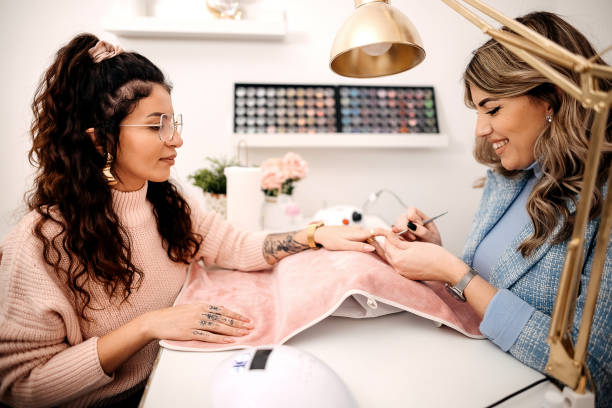
Nail-biting, a common habit that many dismiss as a mere quirk, can sometimes be a manifestation of deeper issues. While it’s easy to categorize it as a bad habit, it goes beyond a simple nervous tick for some individuals. You’re not alone if you’ve pondered the reasons behind your relentless nail-biting.
In fact, many people seek nail-biting therapy in order to get to the root of the issue. It may have been a lifelong habit or one that was acquired along the way. Many people spend time wondering why they can’t seem to stop biting their nails. They might not realize that nail-biting can be more intrusive and difficult to stop doing than they might assume.
How can Nail-Biting be More Than a Bad Habit? What is Onychophagia?

Nail-biting is often considered a harmless habit, a common response to stress or boredom. However, nail biting can lead to tooth damage, fungal infections in the nail bed, and pass along illness through ingestion of germs. Beyond the physical side effects, nail biting can often be a sign of distress or cause distress when you realize that you’re doing it unconsciously. If you have been biting your nails since childhood and/or most days of the week and find it hard to control the urge or hard to stop, you may have Onychophagia!
Onychophagia is classified in the Diagnostic and Statistical Manual of Mental Disorders, 5th edition (DSM-5) under the “Other Specified Obsessive-Compulsive and Related Disorders” subcategory. It is one of the Bodily Focused Repetitive Behaviors (BFRBs). Other examples of BFRBs are trichotillomania and dermatillomania. The treatment model for all of these disorders is the same.
3 Ways to Manage Nail-Biting
1) Identify Triggers:

A trigger is anything that leads to a response and/or behavior. Triggers can be emotions, events, sounds, smells, certain phrases, and more. We know that BFRBs are often triggered by under or over-stimulation. An example of understimulation would be boredom; hence, you may find yourself picking on your nails while mindlessly driving or watching TV. However, overstimulation, such as stress and anxiety before or during a meeting, can trigger an intense amount of nail biting.
Using self-monitoring from the Com-B model will help you start with tracking all the times you are nail-biting. You may realize that you bite your nails consciously (when you are stressed or emotionally disrupted in some way to soothe yourself) or unconsciously (when you are bored and/or distracted, such as when watching TV). You may find that it’s an even mix of the two or that one or the other tends to be more prevalent. If you’re an unconscious biter, recruiting help from someone close to you may help you to keep track. This might be a roommate, a partner, or a parent you live with. If you live alone, you might not have as much access to this support, but you can still ask friends to keep an eye on when you’re together or a trusted colleague at work if you feel safe and comfortable doing so.
You might utilize therapy to help you note, understand, and accept your triggers. Therapy for body-focused obsessions and compulsions focuses on changing the behavior but is also effective in helping you to process what you uncover and the emotions surrounding your discoveries. A session with a therapist who observes how often you bite your nails can help you gain an awareness you might not be able to have on your own. They may be able to see things from an objective point of view that you have trouble identifying or that you avoid processing.
That doesn’t discount the work you will do on your own or what you might learn along the way. Through the process of identifying triggers, you may uncover cues you hadn’t noticed in the past, such as an upset stomach or increased heart rate. These can be signs of anxiety that you deal with by biting your nails.
When you identify triggers, you may realize that you need to make some changes. If you are triggered by having too much time on your hands, signing up for an activity can help. If you are triggered by stress at your job, consider what those stressors are and if you have any way to minimize them. Not all factors are within our control; we have to work, we have to eat, we have to sleep. That is why it is so important to take responsibility for the things that we do have control over.
You may identify that the behaviors of people around you trigger you. This is where having and communicating boundaries comes into play. If the house is always messy and you’re the only one who cleans up, that is a conversation to be had with any other person old enough to throw clothes into a hamper, put dishes in the dishwasher, put things back where they found them, sweep the floors, and so on. Recruit help using “I” statements about your feelings rather than accusations. The same goes if someone says things to or about you that upset or stress you out. Communicate your needs and advocate for yourself.
2) Create a Positive Reinforcement System:

How will you celebrate your achievements and look forward to more? Reinforcement that stems from shame and punishment may seem to be a good motivator, but it is actually better to motivate yourself through positivity. Focusing on feeling good about good choices is much more beneficial than focusing on mishaps is. We thrive in environments of love, support, encouragement, and kindness. This is the same as changing our habits.
Set achievable goals for yourself, such as going a certain period without biting your nails, and reward yourself when you reach these milestones. Positive reinforcement can include treating yourself to a favorite activity, buying a small gift, or simply acknowledging your progress. Creating a positive association with breaking the habit can make the journey more rewarding and sustainable.
Like trichotillomania, there are physical repercussions of nail biting. You may find that looking at your short nails reminds you of your habits; you may even bite so far down that your nail beds are more sensitive. Consider ways that you can be positive about your progress even as you are still looking at shorter nails. Again, your instinct may be to bully yourself about how your fingers look, but this isn’t the most effective way to help yourself.
You may decide that you want to occupy your hands doing something else. Have you wanted to learn (or improve) skills in art, such as drawing, painting, or sculpting? Have you wanted to learn a new language or study a subject you’re interested in? If you are typing in a language app or taking notes from a book, your hands are occupied doing something positive.
Positive reinforcement can be fun! You might create a sticker chart for every day you don’t bite your nails. You might invest in manicures, hand massages, or some other way of spoiling your hands! Maybe you go for your favorite meal if you make it a certain amount of time without nail-biting. Perhaps you “pay yourself” every day that you don’t bite. To stay focused on your goals, you might put up pictures of the reward you’re working towards or set reminders in your phone to pop up throughout the day. Positive visualization is a powerful tool when it comes to making changes in your habits!
Above all, speaking to yourself with kindness is the best way to reinforce the behaviors you want to continue and to get through slips and mishaps. When we say that positive environments support wellness and growth, we mean it. You are your own permanent environment. You live with yourself and hear your thoughts all day, every day. How do you nurture the environment of your existence so that your goals and dreams can thrive?
Affirmations are a great way to cut off negative thoughts and replace them. “This is a learning process for me, and I am doing my best” goes much further than “I am so pathetic! Why can’t I just stop biting my nails?” Take a deep breath, look in the mirror, and tell yourself, “I believe in you. You are doing a great job!” Talk to yourself the way you would talk to a friend; do it in your mind or aloud, even if you’re driving your car on your own or going for a walk. Cheer yourself on the way you would cheer on a friend! Celebrate your victories without shame – anything you’re working on is worth feeling proud of. Savor moments when you feel proud of yourself for not having bitten your nails for a while or when you catch yourself before you bite your nails. Really take time to feel how good you feel, and show yourself some love and respect for continuing to work toward your goals.
3) Seek Professional Help When Needed:

Talk therapy is not good enough to treat nail-biting and other BFRBs; they require Comprehensive Behavioral (Com-B) treatment. Working with our specialists trained in the Com-B model and Habit Training, our goal is to provide valuable insights into the underlying causes of the behavior and offer tailored strategies for managing and overcoming it. Professional support can be instrumental in addressing any emotional or psychological factors contributing to nail-biting, ensuring a more comprehensive approach to breaking the habit.
Habit reversal training for nail-biting (HRT) breaks down into components. The first is to be able to identify the habit. Identifying triggers is an ongoing process that can change over time as triggers and level of awareness change. Someone around you may be able to point out your nail biting if you’re doing it unconsciously. For times when you are alone, you may opt to use bad-tasting nail polish so that you can utilize your senses to remind you. The second step of HRT is the reversal aspect, wherein you substitute the nail-biting for something else, such as keeping your hands and/or mouth busy. You may choose to learn to knit or crochet; you may play with a physical object; you may chew gum or simply hold an item, put on a pair of gloves, or sit on your hands. Maybe now is the time to learn to play piano, take up video games, or follow some online cooking or baking tutorials for foods you’ve wanted to learn how to make.
Once you are able to identify the behavior and have begun working on replacement behaviors, building and maintaining your support network helps to keep you going. No treatment flourishes in isolation. Even though you are responsible for yourself, you can still benefit from having a team behind you. If you feel any embarrassment or shame around seeking help for your nail-biting, then building a support network outside of therapy would definitely be an essential part of your treatment goal. You may connect with people online or in person who also struggle with BFRBs; they may or may not have an official diagnosis, or they may have several. You may be able to learn from them and share with them so that they can learn from you. Mutual support is both empowering and encouraging.
Like hair-pulling or skin-picking, nail-biting is an obsessive and compulsive behavior more complex than simply “deciding not to anymore.” Emotional regulation and mindfulness training can and should be utilized in conjunction with Com-B and HRT to lessen anxiety and decrease the odds of feeling compelled to nail bite. When anxiety rises (as it inevitably will), Cognitive Behavioral Therapy (CBT) can be utilized to avoid taking negative actions. CBT for nail biting is about understanding the thoughts and feelings that lead to biting your nails and modifying the behavior in response.

As you work through treatment for nail biting, you may uncover an unexpected amount of healing to be done. The narrative(s) you have told yourself about who you are, your values, and your strengths and weaknesses might change. There may be some forgiveness of yourself and letting go of the past that you deem necessary to move forward. If you have been infantilized and/or dismissed by the people in your life for biting your nails, you may experience some healing and progress in those relationships, or you may seek compassion and understanding from them that they cannot give. Remember that all things take time; some things take more time than others. You deserve to have people take you seriously, be curious about your experiences, and know that they will do their best to support you. Everyone is on their journey, and not all people in your life can meet you where you are from where they are. Hopefully, you are able to know for yourself that you have done hard work to make a positive change in your life.
Treatment for Nail Biting in Woodland Hills
Do you struggle with nail biting (Onychophagia)? Nail-biting is often an overlooked mental health issue, masking itself as an anxiety tick or a “bad habit” when you are feeling bored or nervous. Maybe you tried No-Bite nail polish or other home remedies to help you manage it, but nothing has worked. It might be time to see an Anxiety Specialist in Woodland Hills or online who understands that BFRBs, such as Nail Biting, are part of the Obsessive-Compulsive Spectrum disorders and need individualized treatment that is more than just talk therapy.
Contact us today for your complimentary 20-minute phone consultation with our Admin Team today!




